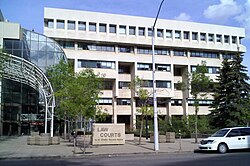| Provincial Courthouse of Alberta (Law Courts, Edmonton) | |
|---|---|
 | |
 | |
| General information | |
| Type | Office building |
| Architectural style | Brutalist |
| Address | 1A Sir Winston Churchill Square |
| Town or city | Edmonton, Alberta |
| Country | Canada |
| Construction started | 1972 |
| Opened | 1973 |
| Owner | Ministry of Justice and Solicitor General of Alberta |
| Landlord | Government of Alberta |
| Technical details | |
| Floor count | 6 |
| Design and construction | |
| Architecture firm | Bell, McCulloch, Spotowski and Associates |
| Other information | |
| Public transit access | |
The Law Courts building is the main courthouse in the city of Edmonton, the capital of Alberta, Canada. It hosts hearings of the Provincial Court of Alberta, the Court of King's Bench of Alberta, and the Court of Appeal of Alberta. [1] The courthouse is located at 1A Sir Winston Churchill Square, in downtown Edmonton. The building was designed by the firm Bell, McCulloch, Spotowski and Associates. [2]
